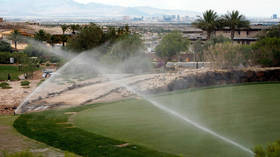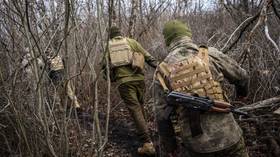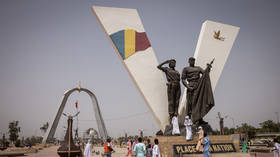Nevada bans GRASS to battle drought, outlaws 31% of Las Vegas turf as ‘non-functional’

The governor of Nevada has signed legislation banning “non-functional” grass in a bid to conserve water as an extreme drought hits more than two-thirds of the state, drying up its major H2O supply.
Signed by Governor Steve Sisolak late last week, the legislation focuses on Nevada’s more populated southern region, giving the state the odd distinction of the first to pass a permanent ban on any type of grass. Other localities have enacted similar prohibitions, but none indefinitely.
“It’s incumbent upon us for the next generation to be more conscious of conservation and our natural resources – water being particularly important,” the governor said, adding that a visible “bathtub ring” around Lake Mead, revealing its diminishing water level, only underscores the need to save on the wet stuff.
Also on rt.com Water fight: Israel turns off Jordan’s water supply amid drought and ‘personal frictions’, media reportsThe new law will make more than 30% of the grass in the greater Las Vegas area illegal when it takes effect, according to the Associated Press, deeming it “non-functional turf” that requires too much water to maintain, much of it drawn from the Colorado River.
The Southern Nevada Water Authority (SNWA) estimated the move will save the region some 9.5 billion gallons of water each year, also noting the law exempts single-family homes.
The measure will not come into force until 2027, however, giving residents some time to plan ahead. Once it does, the SNWA will identify any useless turf within its service area and dispatch removal teams to tear it out.
Gov. Sisolak has signed into law a bill requiring removal of purely decorative grass around town next to businesses, along streets & in traffic circles by the end of 2026. The law will save S NV about 9.5 bil gals of water per year & does not apply to grass in homeowners' yards.
— Southern Nevada Water Authority (@SNWA_H2O) June 6, 2021
Some 76% of Nevada is currently under an “extreme drought,” while more than 94% qualifies for a “severe drought,” depleting lakes and rivers across the state. The Colorado River, a major water source for some 40 million people across several states, is chief among the government’s concerns, with water officials hoping to conserve 11 gallons per person each day from the river, in a region with a population some 2.3 million strong.
Lake Mead, which straddles the border between Nevada and Arizona and is fed by the Colorado River, has also seen a major fall in its water levels. It currently sits at just 37% capacity, with former SNWA head Pat Mulroy saying it looks “like a different world” compared to years prior.
Also on rt.com Europe's drought-induced crop losses tripled in 50 years, threatening future global food supply chainThink your friends would be interested? Share this story!













